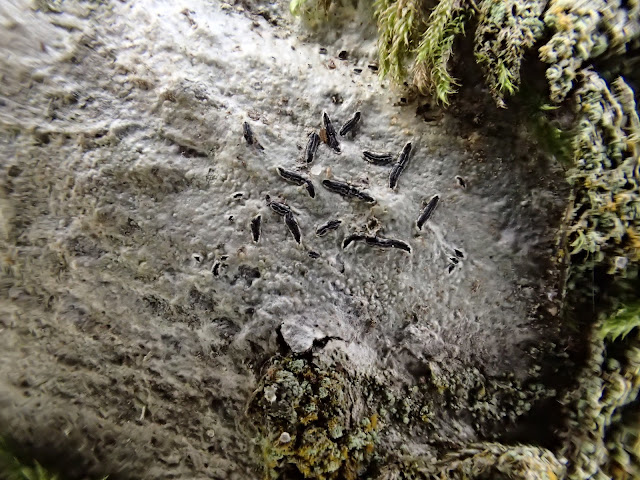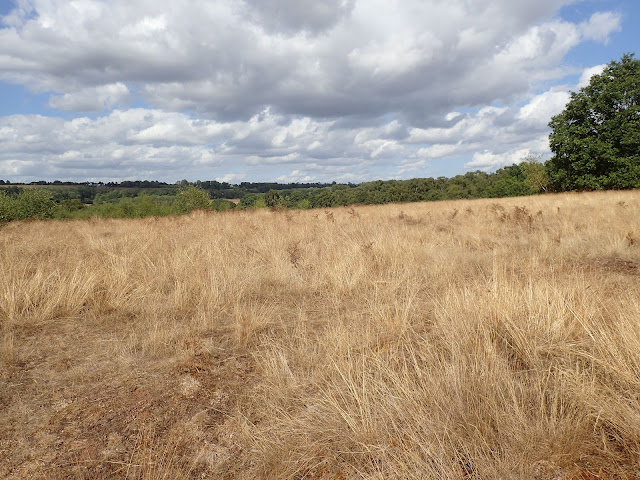Here's my account of the BLS trip to Hampton Park - If there are any misidentifications I am very open to positive suggestions
Sat 20 August 2022: Members of the British Lichen Society defy the drought and meet at Hampton Park SW of Guildford.
The field meeting has been arranged in August as part of the month celebrating the life of Frank Dobson, author of the standard British Lichen Field guide.
Myrtle's Courtyard where we meet is surrounded by parkland with old oak trees. We are greeted by the owner and given a short history of the place.
Some of us will then walk up through what had once been heathland, but is now birch and young oak trees, to the top remaining part of Puttenham Common that is still heathland. Today the grassland and heathland is scorched white by the sun and drought. There are 15 of us.
What will we find?
Here we are, holding our Dobsons. For the record, the white lichen on the brickwork is Lecanora albescens
We set off to the first oak tree near the farm. See how scorched the grass is.
 |
| What is on this branch? |
 |
| Parmelina tiliacea |
 |
| Using Dobson |
On the next tree is some Physconia grisea - fruiting
We try to make it into the much less common Physconia perisidiosa which is isidiate and has black black 'bottle-brush' rhizines, but ours only has white simple rhizines so it is P grisea. |
| More Physconia grisea |
 |
| John Skinner shows me some Schismatomma decolorans. It is the one with medium dark grey isidia. Maxine showed me that it scratches orange yellow green. The pale green lichen is Lecanora expallens |
 |
| The grey lichen here, in the cracks of the dry trunk, with pinkish lumps (when seen very close) is Cliostomum griffithii |
 |
| Melanohalea laciniatula on a spreading side branch of the same tree |
 |
| Opegrapha prosodea |
 |
| Opegrapha prosodea |
 |
| Opegrapha prosodea |
 |
| Andy records the species seen. Photo by Juliet Bailey |
 |
| This is some Graphis scripta growing on an exposed root of the same tree. |
 |
| Phylloblastia inexpectata see distribution map on holly Ha, I have spent quite a lot of time looking for this on box leaves. Now I know what it looks like, I will keep on looking. (Probably P inexpectata I should say. It should be examined microscopically to confirm which species of Protoblastenia) |
 |
We find some good Pyrrhospora quernea with its red apothecia on an oak trunk close to the path. Paul searches hard and reckons he finds a small black apothecium of the new lichenicolous fungus that was only described (if I get this correct) by Neil the previous day. Paul later said: "The new lichenicolous fungus we were looking for on Pyrrhospora was
Lecidella parasitica (see https://fungi.myspecies.info/all-fungi/lecidella-parasitica).
Neil did find it, but what I found turned out to be on Lecanora expallens
not Pyrrhospora, and it appears to be undescribed (see https://fungi.myspecies.info/all-fungi/sclerococcum-sp-p5181).
Lots more to learn about LFs..." Note to self: There is a gap at SD86 in the distribution map for Pyrrhospora quernea where I live - I must look out for it.. though it is quite hard even to find an oak tree in SD86 in Craven, N Yorks |
 |
| Close up |
 |
We are still waiting to see whether it is the usual Usnea subfloridana or whether it could be something else. The base of the holdfast unfortunately does look a bit black as in Usnea subfloridana |
 |
| Lichens on lignum - by Juliet Bailey |
 |
| Posing, to give the scale of the hole (Why is it there?) Looking at Cladonia chlorophaea - photo by Juliet Bailey |
After that it is a brisk, downhill walk back to Myrtle's Courtyard, and tea and cake.









No comments:
Post a Comment